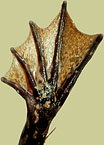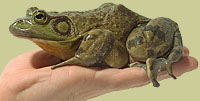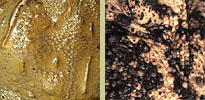
|

|

|

|
|
Three
types of feet: A bullfrog's hind foot (left), a toad's front foot
(middle), and a tree frog's round-toed front foot (right.) [Click
each picture
for a larger image.] Photos by Amy Snyder.
|
|
 frog's
two front legs have four toes each, while the back legs have five toes
each. Aquatic frogs are likely to have long, strong legs with webbed back
feet to help them swim. Frogs that live on land tend to have shorter legs
for walking and climbing. Tree frogs have large, round toe pads that help
them cling to branches. These toe pads work like suction cups to help
the frog cling on to wet leaves and other smooth surfaces.
frog's
two front legs have four toes each, while the back legs have five toes
each. Aquatic frogs are likely to have long, strong legs with webbed back
feet to help them swim. Frogs that live on land tend to have shorter legs
for walking and climbing. Tree frogs have large, round toe pads that help
them cling to branches. These toe pads work like suction cups to help
the frog cling on to wet leaves and other smooth surfaces.
The Costa Rican flying tree
frog soars from branch to branch with the help of its feet. Webbing
between the frog's toes puffs up with air like a parachute, holding
the frog aloft as it sails from tree to tree.

|

American bullfrog (
Rana catesbiana
); not to be confused with
a toad. [
Click
for a larger image.]
Photo by Amy Snyder.
|
|
|
Frogs
and Toads:
What's the difference?
Technically
speaking, toads are frogs. Both are members of the order Anura,
a group that experts usually refer to simply as frogs. Within
this large group, the name "toad" is given to those with dry,
warty skin and short hind legs for walking instead jumping. Meanwhile,
those with smooth, moist skin and long, strong, webbed hind legs
for swimming and jumping are called frogs. In general, frogs live
in moist climates and lay their eggs in clusters, while toads
live in drier climates and lay their eggs in long chains. But
be warned: drawing the line between frogs and toads can be tricky.
For example, there are frogs with warty skin, and toads with slimy
skin. Many species fit equally well into both categories.
|
|
|
 Exploratorium
staff frogkeeper Ned McAllister discusses the
feeding
habits
of frogs, toads, and tadpoles. [Need
Help
?]
Exploratorium
staff frogkeeper Ned McAllister discusses the
feeding
habits
of frogs, toads, and tadpoles. [Need
Help
?]
|
Spadefoot
toads have hard, horn-like growths on their hind feet. These claw-like
"spades" help them dig cool underground burrows in the dry climates
where they live. Unlike most animals, spadefoot toads dig backwards.
While digging with their hind feet, they move in a backward spiral and
gradually disappear into the earth.

Frogs eat almost any live prey they can find, including insects, snails,
spiders, and worms, or small fish. Some larger frogs eat even larger
prey: The ornate horned frog of Argentina can gulp up a mouse in one
mouthful. All prey gets swallowed whole, because frogs can't chew. If
they have teeth at all, they are usually only on the upper jaw, used
for holding onto prey and not for biting or chewing.
Some frogs catch insects
with a long sticky tongue. It takes less than a second for a frog's
tongue to roll out, adhere to prey, and roll back into the frog's mouth.
High-speed photography has revealed that frog's eyes shut completely
as the tongue is shot out. Since frogs can't see while they're striking,
they can only make a catch by taking careful aim in advance. Meanwhile,
not all frogs have tongues. Tongueless frogs use their fingers to catch
prey and stuff it into their mouths.
Catching fast-moving insects requires good eyesight. Frogs' large eyes
see a wide range of colors and also see well in dim light. It's nearly
impossible to sneak up on a frog, because their bulging eyes help it
to see in all different directions without moving its head. The positioning
of the eyes -- on top of head -- allows a frog to sit in the water with
only its eyes and nose above the surface.
Frogs' eyes have a surprising
auxiliary function: they help in swallowing. As a frog swallows its
prey, the eyes sink through openings in the skull and help force the
food down the throat. This is why frogs seem to blink as they eat.
|

|

|
|
Two
types of skin: Moist, slimy frog skin, and drier, wartier toad skin.
[
Click
to for a larger image.] Photos by
Amy Snyder.
|
|
|
|
|

Frogs' skin is critical to their survival. Through it, they both drink
and breathe. Frogs don't swallow water; they get all the moisture they
need through their skin. And though frogs have lungs, they rely on the
extra oxygen they absorb through their skin, especially when they're
underwater.
Frogs must keep their skin
moist. Otherwise, oxygen can't pass easily through it and the frog suffocates.
Frog skin secretes a mucus that helps keep it moist. Even so, their
skin tends to dry out easily, which is why they usually stay near bodies
of water. Toads' skin doesn't lose moisture as quickly, so they can
live farther from water than most frogs. In a pinch, frogs and toads
can rely on dew for moisture, or burrow underground into moist soil.
About once a week, frogs shed their skin. The process begins with the
frog doing a lot of twisting, bending, and stretching to loosen the
old skin. Then the frog pulls the skin over its head like a sweater
and -- usually -- eats it.
|




